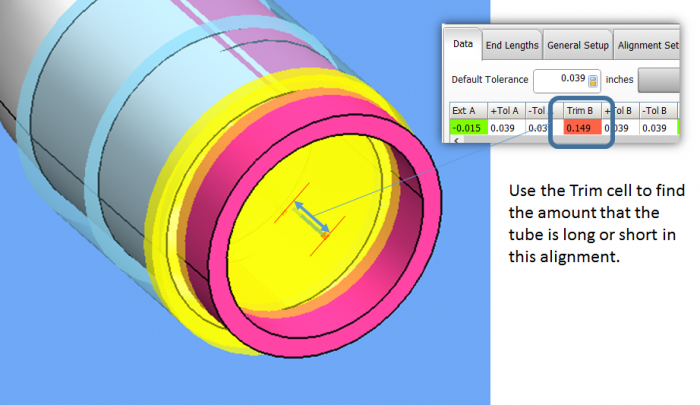Difference between revisions of "VTube-LASER End Point Deviations"
(→Three Main End Point Deviations) |
(→Three Main End Point Deviations) |
||
| Line 28: | Line 28: | ||
</table> | </table> | ||
| + | ====END LENGTH Deviations ==== | ||
<table cellpadding=10> | <table cellpadding=10> | ||
<tr valign=top> | <tr valign=top> | ||
<td width=800> | <td width=800> | ||
| − | |||
The end length deviations are found at the top of the Inspection menu. | The end length deviations are found at the top of the Inspection menu. | ||
<br><br> | <br><br> | ||
| Line 41: | Line 41: | ||
</tr> | </tr> | ||
</table> | </table> | ||
| + | |||
| + | ====AFTER-TRIM Deviations ==== | ||
| + | <table cellpadding=10> | ||
| + | <tr valign=top> | ||
| + | <td width=800> | ||
| + | These are found in the first T1 value and the last T2 value in the Tangents grid. | ||
| + | <br><br> | ||
| + | These deviations show the expected radial deviation if it were trimmed. | ||
| + | </td> | ||
| + | <td width=700> | ||
| + | [[image:vtl after-trim deviations.png|700px]] | ||
| + | </td> | ||
| + | </tr> | ||
| + | </table> | ||
| + | |||
<br><br> | <br><br> | ||
Revision as of 01:22, 2 December 2016
|
|
Contents |
Three Main End Point Deviations
|
There are three main end point deviation values calculated during an alignment of the MEASURED to the MASTER tube. |
END LENGTH Deviations
|
The end length deviations are found at the top of the Inspection menu.
|
AFTER-TRIM Deviations
|
These are found in the first T1 value and the last T2 value in the Tangents grid.
|
Tangent Point Deviations in the Inspection Data Grid
|
The Tangent chart is represented by a grid of straights for each row with tangent points and midpoints for each straight:
Note that the two end points are also included in the tangent charts are reports (T1d in straight 1, and T2d in the last straight). They are an exception to the technical tangent definition given above because there is no bend attached to these points. But these points still have value in determining if the part is the correct shape, so it is convenient to include them in this chart and grid - even though they are not really tangents. Midpoint deviations are always less than the highest corresponding tangent deviation, and higher than the lowest corresponding tangent deviation. They are included in traditional reports so that you can have three separate deviation tolerances in a straight. (T1-MP-T2)
|
The Same Data In Reports
|
The same tangent data can be shown in the reports like this. |
How to Understand the Tangent Data
How to Understand the End Point Deviations
Automatic Internal Trimming of End Points for Shape
|
Even though the end points are not tangents, we can still use them in the chart because they qualify the part the same way that tangent points do. |
Untrimmed End Points for Lengths
|
However, the end length is 90.2mm too long. In this application, the customer bent the part 90mm too long on purpose in order to give the bend arm clamp die enough material on the first straight to grip. Notice that, even though the part is significantly too long, the BEST FIT algorithm didn't use the actual measured end point in the alignment. The alignment was based on the trimmed point on the measured centerline that was nearest the master end point. So, in this case the part shape in space is qualified - but it needs trimming by 90.2mm to also qualify the end length (another critical qualifier). |
Typical Industry Tangent Point Tolerances
|
In working with thousands of customers over the past few decades, we've seen some trends in accepted envelope deviation tolerances. Here are what we commonly see: Aerospace and Automative Fluid Lines
Automotive Exhaust Pipes
Shipbuilding
HVAC
Structural Tubes (Frames)
Tighter TolerancesSometimes customers will required +/-0.75 mm - but this is very rare. We've never seen tube shapes that must be qualified with a deviation tolerance of less than +/- 0.75 mm. |
Other Pages
- See also VTube Intersection Point Tolerances
- Back to VTube-LASER













